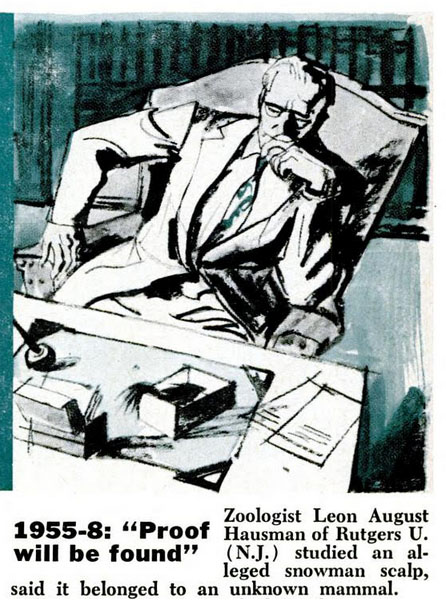1957: Zoologist Studies Yeti Scalp
Sometimes the simpliest of claims can prove the most frustrating to double-check. For example, the above snippet was run in a 1957 article in Popular Science that very briefly summed up the claims made for evidence of the wildman of the Himalayas, the Yeti. And, as you can see, it's a pretty straightforward claim... it names who was involved, what they did, and what the conclusion was, which then lends evidence to the possibilty of an unknown animal related to the claims. And yet...
Leon Augustus Hausman [1888-1966] (not 'August', as shown above) was the Emeritus Professor of Zoology at Rutgers University, and was a noted ornithologist -- specialist in birds -- and a well-known authority on the study and identification of hair samples, who used this specialization as an expert witness in various criminal cases ranging from fraud to murder... so he would indeed be a good person to ask to study a sample of unknown fur for possible identification. Yet I can find no earlier evidence than the 1957 snippet above connecting him to the study of the Yeti.
In 1958, however, Bernard Heuvelmans published his groundbreaking work on the topic of Cryptozoology titled On The Track of Unknown Animals, and in it Heuvelmans give us a little more information about the story of Hausman and the Yeti scalp. On October 9, 1953, a group of six mountaineers and scientists were shown what was identified as a sacred Yeti scalp at the monastery of Pangboche. The group took pictures, as it was clear that they would not be allowed to take the sacred object, and they were allowed to take a single hair from the scalp... and this is what was sent to Leon Augustus Hausman to examine, not a full scalp as the snippet above alledges.
Heuvelmans goes on to state that samples from the Pangboche scalp and two others found shortly thereafter were sent to a number of experts for identification. The study of the samples only works in comparisons; a hair alone cannot tell you what type or species of animal it belonged to... so the hairs must be compared against known animals to find a match. Heuvelmans stated that the samples were compared to all known animal species living in the Himalayas, and no match was found. Heuvelmans also states that Dr. Hausman in particular suspected that the sample belonged to an animal that was not native to the Himalayas, and that was likely brought in by travellers... so it's unlikely Hausman felt he was looking at the hair of an unknown primate, as implied by the snippet from Popular Science.
Hausman himself does not seem to have ever written about studying the hair, despite having over twenty books and manuscripts published, as well as being something of a regular contributor to Scientific American. It was proven the topic was of interest to Hausman in 1962, when his name was included as a founding member of the "International Committee for the study of the human-like hairy bipeds," which was announced in the journal Genus... it was founded "for the purpose of studying and exchanging information about the alledged Snowman and other hairy bipeds still little known to science and about which ancient documents and recent testimony are becoming ever more abundant." Which is why I continue to find it strange that I can still find no earlier mention of Hausman studying the 'Yeti' hair than the 1957 Popular Science article.
One thought that does come to mind, however, is this: the article in Popular Science had no author attributed to it. Given that Heuvelmans' book came out in 1958, is it possible that the Popular Science article was either written by or in consultation with Heuvelmans? It would be a good way to keep interest in the topic alive while a book was being pushed through a publisher... and would explain why Heuvelmans seems to be the only person who knows anything about Hausman's involvement with the 'Yeti' sample to begin with. And I'll likely never know for sure!
Anomalies -- the Strange & Unexplained, as well as my other website -- Monsters Here & There -- are supported by patrons, people like you! All new Anomalies articles are now posted for my patrons only, along with exclusive content made just for them. You can become a patron for just $1 a month!
|






 [
[

